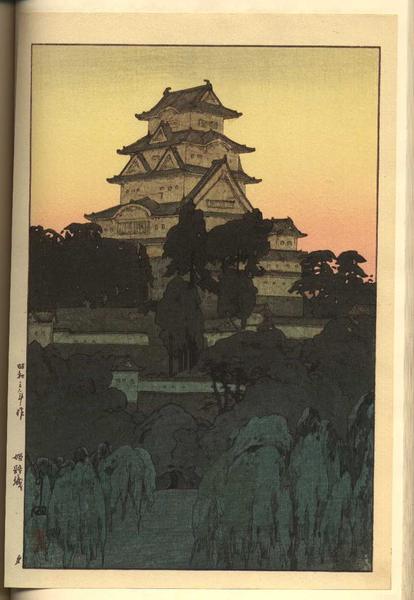| Notes (this edition)?: |
| The following information was taken from the original web listing of this artwork. Note that there may be some inaccuracies:
Himeji Castle by Hiroshi Yoshida. Original woodblock print and book circa 1928 (Showa 3). Extra fine condition, color and impression. Brush signed in lower left of image above red Yoshida seal. Date and title in left margin. (Jizuri seal not applied to any of this version of Himeji Castle. See illustration #252 in "The Complete Woodblock Prints of Yoshida Hiroshi".) Strong ink bleed through. Nice baren rubbings. 15.2 x 10.2 inches. Tipped inside of the book "Enthronement of the One Hundred Twenty-Fourth Emperor of Japan, The Japan Advertiser". 1928. Wonderful book about the role of the Emperor in Japan. Published to honor Hirohito's enthronement. 180 pages. Many interesting illustrations. Dyed cover design is also by Hiroshi Yoshida. Book size is 17.0 x 12.5 inches. Book is in fine condition. DJ is tattered.
Japan Advertiser. Folio, 17 x 12.5 inches, 180p., Japanese style binding, purple silk covers, ribbon tied,with an elaborate phoenix design, glossary, many b.w. photos.RARE With 38 essays by noted scholars. Including an original col- or woodblock print by Hiroshi Yoshida. With essays: CEREMON- IES OF ACCESSION by Zoe Kincaid. LIFE OF THE EMPEROR by Cou- nt Yoshinori Futara. LIFE OF THE EMPEROR by Masano Futara, HISTORY OF THE ENTHRONMENT by Masano Sekine. HEART OF THE ENTHRONMENT by Etsu Inagaki Sugimoto. IMPERIAL PALACE IN TOKYO by Frank H. Hedges. REGALIA OF THE JAPANESE THRONE by Hanso Tarao. COURT FESTIVALS THROUGHOUT THE YEAR BY Teruoki Hoshino. GRAND SHRINE AT ISE. HARVEST RITES by D.C. Holtom, CHRYSANTHEMUM IN FLOWER BY F.H Burnett. PHOENIS AND THE ENT- HRONMENT by T. Suzuki. RESCRIPTS OF THE EMPEROR. COURT MUSI- CANS BY Tadatomo Ohno. IMPRESSIONS OF COURT MUSIC by Henry Eichheim. BUGAKU BY D. DEAN. CEREMONIAL COURT COSTUMES by S. Yatsuka. WOMEN'S COURT COSTUMES by H. Morgan. TREASURES OF THE SHOSOIN by J. Harada. KYOTO, IMPERIAL CITY. EARLY FORE- IGN CONTACT, plus several others. Excellent source. R A R E
|
|
| Artist Bio: |
Yoshida Hiroshi (1876-1950)
This article is a review of the book The complete Woodblock Prints of Yoshida Hiroshi published by ABE Corporation, ISBN 4-87242-121-3.
Portrait of Yoshida Hiroshi
Yoshida Hiroshi is considered one of the leading figures of the renewal of Japanese printmaking after the end of the Meiji period (1912). The renewal was based on two groups of artists, the shin hanga (modern prints) and the sosaku hanga (creative prints) movement.
The Son of a School Principal
Yoshida Hiroshi was born as the son of an elementary school principal. His artistic talent was discovered early and at the age of 18 he entered a private art school in Tokyo.
Yoshida started as a painter and soon won many exibition prizes. But it was not before 1920 that he started creating woodblock prints. Yoshida Hiroshi then met Watanabe Shozaburo, publisher and owner of the Watanabe print store in Tokyo. Watanabe published the first seven of Yoshida Hiroshi's woodblock prints.
The Making of a Japanese Print
The Shalimar Gardens, 1932
The traditional process of creating a Japanese woodblock print was a cooperation of three strictly separated skills: the artist who designed the print subject, the carver and finally the printer and publisher. In contrast, the sosaku hanga followers believed that the process of creating a print - design, carving, printing - should be performed by the artist himself.
Although Yoshida is usally considered as a member of the shin hanga movement, he followed the same ambitions of creating a print by himself.
In 1923 Watanabe's store was completely destroyed in the fires that followed the great earthquake. All of Yoshida's woodblocks and more than a hundred of his prints were lost.
After coming back from his third visit to the United States, Yoshida in 1925 started employing his own artisan carvers and printers. He supervised them very closely and often he carved a block himself. He thought that he had to be more skilled in all aspects of producing a print than each of his workers.
Yoshida Hiroshi - an Avid Traveller
Kinoe, 1930
Yoshida travelled a lot. He came to the United States, Europe, Africa, India, China, Korea and througout Japan. Another passion was mountaineering. He even established an association called Nihon Sangakuga Kyokai, the Japan Alpine Artist Association. His prints reflect both his love for travelling and for mountains. Most of his prints show landscape scenes from his travels and mountain subjects from Japan and the European Alps.
Although his roots were in Japanese traditions, Yoshida was a real cosmopolitan artist who merged both worlds to something new and fascinating. When looking at his print scenes from abroad, you have the impression of being "on the spot". Yoshida is cited with the words "True art is cosmopolitan and the result therefore of external influences as well as of the inherent vitality and life of the different nations". Towards the end of his life, he planned a series entitled One Hundred Views of the World. Yoshida died before he could put his dream into reality.
At the end of his life, Yoshida Hiroshi had created 259 woodblock prints - seven published by Watanabe and the rest by Yoshida himself. It should not be forgotten that he gave the world even more than his own works of art: His both sons, Toshi and Hodaka Yoshida became great artists themselves.
The 1985 Commemorative Collection edition (西集記念)
From http://www.shogungallery.com/wwwboard/archive/oldmess/17.html :
In 1985, to celebrate a major exhibition of Hiroshi Yoshida's prints in Japan, Hiroshi's son, Toshi (an artist in his own right) published a number of his father's prints in commemoration, from the original blocks. These prints were of very high quality and according to Toshi limited to 300 impressions.
|
|



